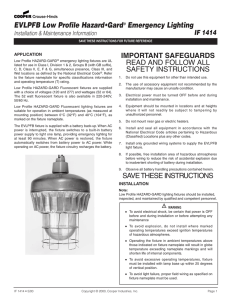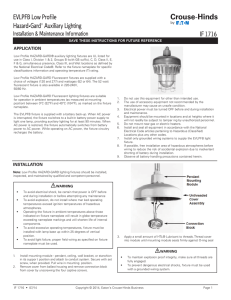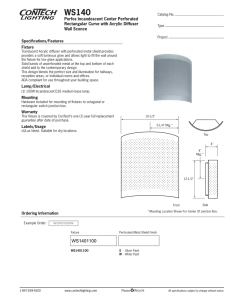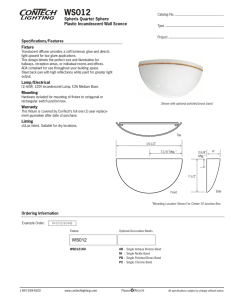EVLPF Low Profile Hazard•Gard Fluorescent Lighting IF 1409 Installation & Maintenance Information
advertisement
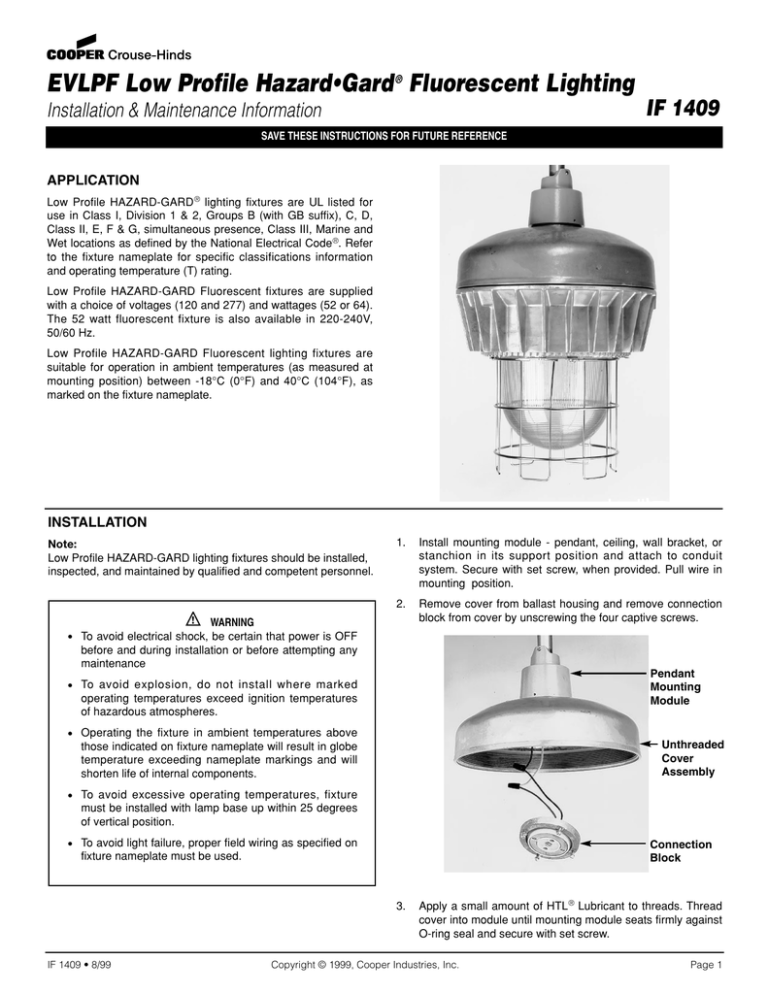
EVLPF Low Profile Hazard•Gard ® Fluorescent Lighting IF 1409 Installation & Maintenance Information SAVE THESE INSTRUCTIONS FOR FUTURE REFERENCE APPLICATION Low Profile HAZARD-GARD ® lighting fixtures are UL listed for use in Class I, Division 1 & 2, Groups B (with GB suffix), C, D, Class II, E, F & G, simultaneous presence, Class III, Marine and Wet locations as defined by the National Electrical Code ®. Refer to the fixture nameplate for specific classifications information and operating temperature (T) rating. Low Profile HAZARD-GARD Fluorescent fixtures are supplied with a choice of voltages (120 and 277) and wattages (52 or 64). The 52 watt fluorescent fixture is also available in 220-240V, 50/60 Hz. Low Profile HAZARD-GARD Fluorescent lighting fixtures are suitable for operation in ambient temperatures (as measured at mounting position) between -18°C (0°F) and 40°C (104°F), as marked on the fixture nameplate. INSTALLATION Note: Low Profile HAZARD-GARD lighting fixtures should be installed, inspected, and maintained by qualified and competent personnel. 1. Install mounting module - pendant, ceiling, wall bracket, or stanchion in its support position and attach to conduit system. Secure with set screw, when provided. Pull wire in mounting position. 2. Remove cover from ballast housing and remove connection block from cover by unscrewing the four captive screws. ! • WARNING To avoid electrical shock, be certain that power is OFF before and during installation or before attempting any maintenance • To avoid explosion, do not install where marked operating temperatures exceed ignition temperatures of hazardous atmospheres. • Operating the fixture in ambient temperatures above those indicated on fixture nameplate will result in globe temperature exceeding nameplate markings and will shorten life of internal components. • To avoid excessive operating temperatures, fixture must be installed with lamp base up within 25 degrees of vertical position. • To avoid light failure, proper field wiring as specified on fixture nameplate must be used. Pendant Mounting Module Unthreaded Cover Assembly Connection Block 3. IF 1409 • 8/99 Apply a small amount of HTL ® Lubricant to threads. Thread cover into module until mounting module seats firmly against O-ring seal and secure with set screw. Copyright © 1999, Cooper Industries, Inc. Page 1 Captive Screws Set Screws • • 4. ! WARNING To maintain explosion proof integrity, make sure all threads are fully engaged. To prevent dangerous electrical shocks, fixture must be used with a grounded wiring system. 6. Loosen locking tab screw on housing and slide tab up out of the way. Unscrew globe assembly from ballast housing. 7. Apply a small amount of HTL Lubricant to threads. Rethread ballast housing onto cover assembly until cover assembly seats firmly against O-ring seal and secure with set screw. Connect connection block wires to field wiring following approved methods. • Install circuit grounding wire to green grounding screw near sealing well in connection block. Tighten green grounding screw securely. O-Ring Seal Note: Install in accordance with National Electrical Code. Sections 250-78 and 501-16, utilizing an approved method of installation, to make sure electrical continuity is provided. • Attach ungrounded primary field wire to BLACK conductor and other field wire to RED conductor. ! WARNING To maintain explosion proof integrity, make sure all threads are fully engaged. ! CAUTION To avoid light fixture failure and exceeding marked operating temperature use only lamp type and wattage specified on nameplate of fixture. Connection Block 5. Insert connection block into cover and tighten four captive screws, as follows: • • • Push conductors back up into mounting module. Seat connection block securely into cover. Start all four captive screws into cover and tighten evenly. IF 1409 • 8/99 8. Install lamp into lamp holder of ballast housing. Use only correct lamp as specified on the fixture nameplate. 9. Apply a small amount of HTL Lubricant to threads. Rethread globe/guard assembly on ballast housing until assembly seats firmly against O-ring seal. Slide locking tab into position, so it engages slot on globe assembly. Make sure to properly tighten screw to secure locking tab Copyright © 1999, Cooper Industries, Inc. Page 2 Electrical Preventive Maintenance Program as described in the National Fire Protection Association Bulletin NFPA No. 70B. Ballast Housing Globe/Guard Assembly 2. The globe and reflector should be cleaned periodically to insure continued lighting performance. To clean, wipe the reflector then the globe with a clean, damp, soft cloth. If this is not sufficient, use a mild soap or a liquid cleaner such as Collinite NCF or Duco #7. Do not use an abrasive, strong alkaline, or acid cleaner. Damage to the reflector may result. 3. Check slip ring on connection block for electrical continuity. • • ! WARNING To avoid electrical shock and possible explosion while performing maintenance, electrical power must always be turned off and the area free of hazardous gas or vapors. To avoid burning your hands while performing maintenance, make sure globe and lamp are cool. Remove any surface contamination by lightly polishing contact ring(s). Carefully bend contacts up to form a 45° angle. 10. Install reflector, if provided. 11. Turn power on. REFLECTOR INSTALLATION RELAMPING: Optional Reflectors: 1. Disconnect power to fixture and allow unit to cool completely. 2. Optional reflectors are attached to the Low Profile HAZARDGARD fixtures as follows: Loosen screw that secures locking tab. Lower tab and retighten screw to hold locking tab temporarily out of the way. 3. Unscrew globe/guard assembly and remove old lamps. 1. 4. Install new lamps with identical type lamp as marked on fixture nameplate. 5. Thoroughly clean or replace O-ring seal. 6. Apply a small amount of HTL Lubricant to threads. Rethread globe/guard assembly onto ballast housing until assembly seats firmly against O-ring seal. Secure with locking tab, making sure tab engages slot on globe assembly. • • 30° Angle RA739 Dome RD739 Place reflector in position on fixture lower housing. When correctly placed, all three tabs of reflector are located between reflector mounting plates. Note: Angle reflector should be installed closest to final mounting position. 2. Rotate reflector clockwise so that the three tabs slide under captivating plates on housing. 3. Continue to rotate reflector clockwise until reflector tabs engage final captivating bosses and reflector “snaps” into position. 4. Adjust angle reflector to its final orientation by loosening set screws at mounting module joint and turning fixture clockwise. Make sure to retighten set screw. REFLECTOR REMOVAL The reflector can be removed by rotating it counterclockwise until the three reflector tabs are free of the captivating plates. REPLACEMENT PARTS: Low Profile HAZARD-GARD lighting fixtures are designed to provide years of reliable lighting performance. However, should the need for replacement parts arise, they are available from your Crouse-Hinds distributor. Assistance may also be obtained through your local Crouse-Hinds representative or the CrouseHinds Sales/Service Department, P.O. Box 4999, Syracuse, New York 13221, Phone 315-477-5531. MAINTENANCE 1. Perform visual, electrical, and mechanical inspections on a regular basis and replace worn or damaged parts as necessary. This should be determined by the environment and frequency of use. However, it is recommended that checks be made at least once a year. We recommend an IF 1409 • 8/99 Copyright © 1999, Cooper Industries, Inc. Page 3 WIRING DIAGRAM EVLPF 52 and 64 Watt (120, 220 OR 277V) All statements, technical information and recommendations contained herein are based on information and tests we believe to be reliable. The accuracy or completeness thereof are not guaranteed. In accordance with Crouse-Hinds "Terms and Conditions of Sale", and since conditions of use are outside our control, the purchaser should determine the suitability of the product for his intended use and assumes all risk and liability whatsoever in connection therewith. Cooper Industries Inc. Crouse-Hinds Division PO Box 4999, Syracuse, New York 13221 • U.S.A. Copyright© 1999, Cooper Industries, Inc. IF 1409 Revision 2 Revised 8/99 Supercedes 4/99
